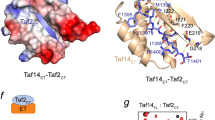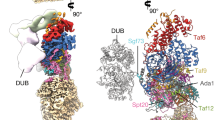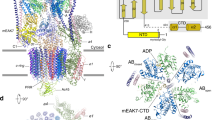Abstract
BIOCHEMICAL and genetic studies suggest the existence of mediators that work between the activation domains (ADs) of regulatory proteins and the basic transcriptional machinery. We have previously shown genetically that Sugl interacts with the AD of the yeast activator Ga141. Here we provide evidence that the Sugl protein of yeast binds directly to the ADs of Gal4 and the viral activator, VP16. Sugl protein is associated with the TATA-binding protein in vivo and binds to it in vitro, consistent with a mediator function. We also demonstrate that Sugl is not a component of the 26S proteasome, contrary to previous reports2–5. Sugl is a member of a large, highly conserved family of ATPases, implying a role for ATP hydrolysis in the activation of transcription.
This is a preview of subscription content, access via your institution
Access options
Subscribe to this journal
Receive 51 print issues and online access
$199.00 per year
only $3.90 per issue
Buy this article
- Purchase on Springer Link
- Instant access to full article PDF
Prices may be subject to local taxes which are calculated during checkout
Similar content being viewed by others
References
Swaffield, J. C., Bromberg, J. & Johnston, S. A. Nature 357, 698–700 (1992).
Dubiel, W., Ferrell, K., Pratt, G. & Rechsteiner, M. J. biol. Chem. 267, 22699–22702 (1992).
Dubiel, W., Ferrell, K. & Rechsteiner, M. FEBS Lett. 323, 276–278 (1993).
Rechsteiner, M., Hoffman, L. & Dubiel, W. J. biol. Chem. 268, 6065–6068 (1993).
Ghislain, M., Udvardy, A. & Mann, C. Nature 366, 358–362 (1993).
Berger, S. L. et al. Cell 70, 251–265 (1992).
Nishizawa, M., Suzuki, Y., Nogi, Y., Matsumoto, Y. & Fukasawa, T. Proc. natn. Acad. Sci. U.S.A. 87, 5373–5377 (1990).
Himmelfarb, H. J., Pearlberg, J., Last, D. H. & Ptashne, M. Cell 63, 1299–1309 (1990).
Gordon, C., McGurk, G., Dillon, P., Rosen, C. & Hastie, N. D. Nature 366, 355–357 (1993).
DeMartino, G. et al. J. biol. Chem. 269, 20878–20884 (1994).
McGuire, M. J., McCullough, M. L., Croall, D. E. & DeMartino, G. N. Biochim. biophys. Acta 995, 181–186 (1989).
Eytan, E., Ganoth, D., Armon, T. & Hershko, A. Proc. natn. Acad. Sci. U.S.A. 86, 7751–7755 (1989).
Leuther, K. K., Salmeron, J. M. & Johnston, S. A. Cell 72, 575–585 (1993).
Triezenberg, S. J., LaMarco, K. L. & McKnight, S. L. Genes Dev. 2, 730–742 (1988).
Lue, N. F., Chasman, D. I., Buchman, A. R. & Kornberg, R. D. Molec. cell. Biol. 7, 3446–3451 (1987).
Confalonieri, F., Marsault, J. & Duguet, M. J. molec. Biol. 235, 396–401 (1994).
Tomayazu, T. et al. J. Sact. 175, 1344–1351 (1993).
Söllner, T., Bennett, M. K., Whiteheart, S. W., Scheller, R. H. & Rothman, J. E. Cell 75, 409–418 (1993).
Erdmann, R. et al. Cell 64, 499–510 (1991).
Thorsness, P. E., White, K. H., Fox, T. D. Molec. cell. Biol. 13, 5418–5426 (1993).
Nobrega, F. G., Nobrega, M. P. & Tzagoloff, A. EMBO J. 11, 3821–3829 (1992).
Kim, Y.-J., Bjorklund, S., Li, Y., Sayre, M. H. & Kornberg, R. D. Cell 77, 599–608 (1994).
Koleske, A. J. & Young, R. A. Nature 368, 466–469 (1994).
O'Connor, V., Augustine, G. J. & Betz, H. Cell 76, 785–787 (1994).
Lee, J. W., Ryan, F., Swaffield, J. C., Johnston, S. A. & Moore, D. D. Nature 374, 91–94 (1995).
Cormack, B. P., Strubin, M., Ponticelli, A. S. & Struhl, K. Cell 65, 341–348 (1991).
Gill, G. & Tjian, R. Cell 65, 333–340 (1991).
Hough, R., Pratt, G. & Rechsteiner, M. J. biol. Chem. 262, 8303–8313 (1987).
Waxman, L., Fagan, J. M. & Goldberg, A. L. J. biol. Chem. 262, 2451–2457 (1987).
Ma, C.-P., Slaughter, C. A. & DeMartino, G. N. J. biol. Chem. 267, 10515–10523 (1992).
Author information
Authors and Affiliations
Rights and permissions
About this article
Cite this article
Swaffield, J., Melcher, K. & Johnston, S. A highly conserved ATPase protein as a mediator between acidic activation domains and the TATA-binding protein. Nature 374, 88–91 (1995). https://doi.org/10.1038/374088a0
Received:
Accepted:
Issue Date:
DOI: https://doi.org/10.1038/374088a0
This article is cited by
-
The ubiquitin–proteasome system regulates p53-mediated transcription at p21waf1 promoter
Oncogene (2007)
-
Rpt6
AfCS-Nature Molecule Pages (2007)
-
Roles for APIS and the 20S proteasome in adenovirus E1A-dependent transcription
The EMBO Journal (2006)
-
Interaction Proteomics
Bioscience Reports (2005)
-
Minimal protein-folding systems in hyperthermophilic archaea
Nature Reviews Microbiology (2004)
Comments
By submitting a comment you agree to abide by our Terms and Community Guidelines. If you find something abusive or that does not comply with our terms or guidelines please flag it as inappropriate.



